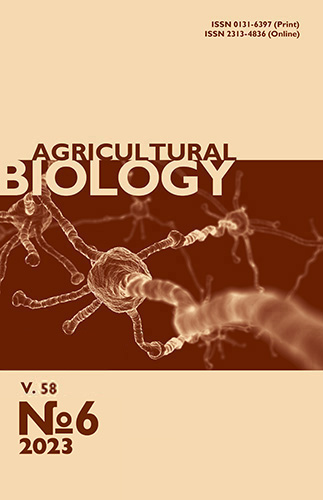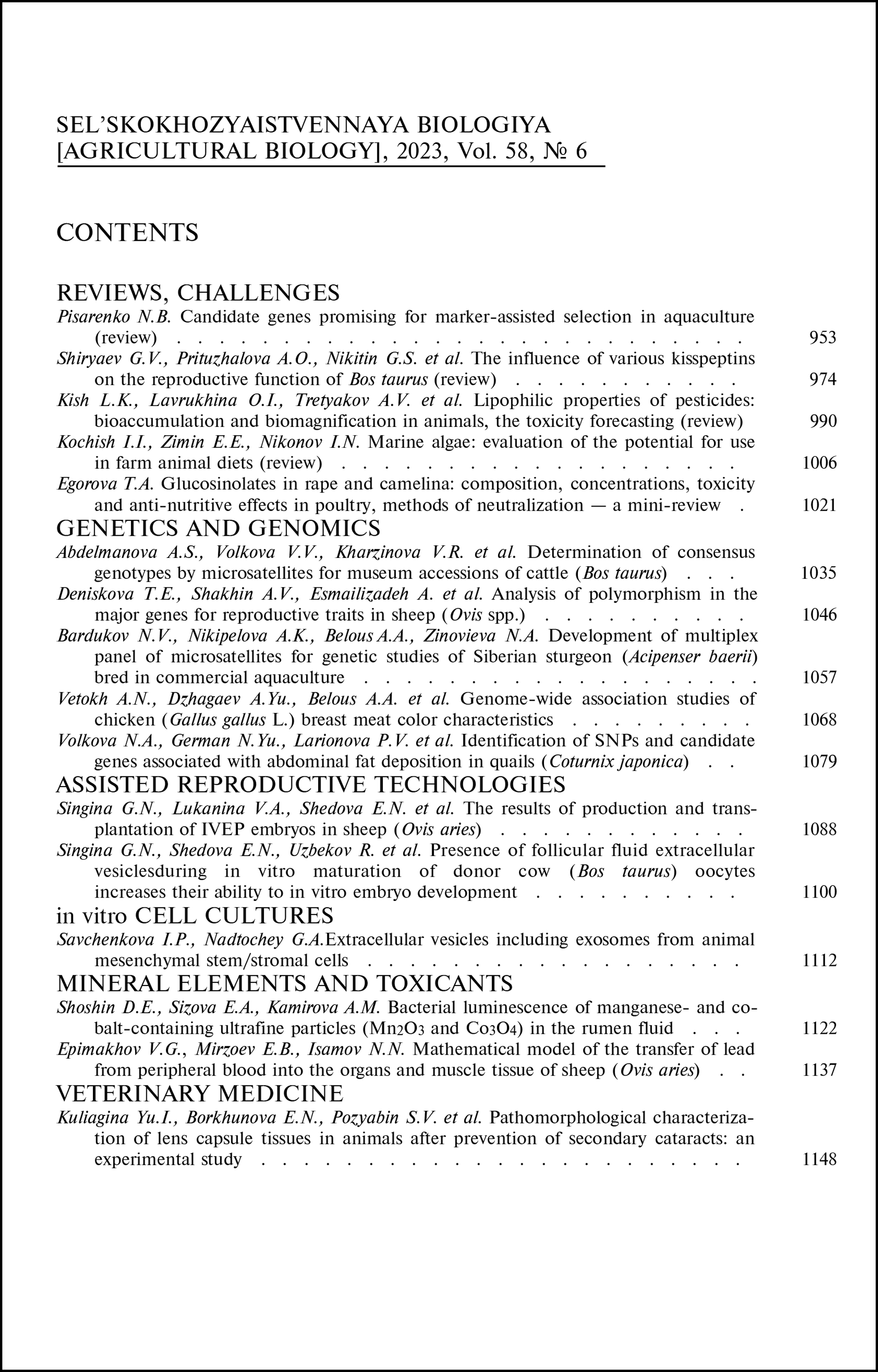doi: 10.15389/agrobiology.2023.6.1088eng
UDC: 636.3:591.391.1:57.085.23
Acknowledgements:
Supported financially by the Ministry of Science and Higher Education of the Russian Federation
THE RESULTS OF PRODUCTION AND TRANSPLANTATION OF IVEP EMBRYOS IN SHEEP (Ovis aries)
G.N. Singina ✉, V.A. Lukanina, E.N. Shedova, R.Yu. Chinarov,
E.A. Gladyr, E.V. Tsyndrina
Ernst Federal Research Center for Animal Husbandry, 60, pos. Dubrovitsy, Podolsk District, Moscow Province, 142132 Russia, e-mail g_singina@mail.ru (✉ corresponding author), kristybatle@gmail.com, shedvek@yandex.ru,
roman_chinarov@mail.ru, elenagladyr@mail.ru, vip.krilochkina@mail.ru
ORCID:
Singina G.N. orcid.org/0000-0003-0198-9757
Chinarov R.Yu. orcid.org/0000-0001-6511-5341
Lukanina V.A. orcid.org/0000-0003-4744-7873
Gladyr E.A. orcid.org/0000-0002-5210-8932
Shedova E.N. orcid.org/0000-0002-9642-2384
Tsyndrina E.V. orcid.org/0000-0002-3263-2358
Final revision received July 19, 2023
Accepted August 03, 2023
In vitro embryo production (IVEP) in sheep is necessary to develop because of its use in breeding and conservation of valuable animals and possible creation of new genotypes by genomic editing. In the present work for the first time in national practice, full-fledged ovine embryos were produced in vitro and live lambs were born after their transplantation to recipient ewes. The aim of this work was to model the main steps of IVEP technology in this species, and to evaluate its efficiency in vitro and in vivo. Female germ cells were obtained post mortem from the ovaries of sexually mature ewes and sheep of various breeds and ages after slaughtering. Oocyte-cumulus complexes (OCC) (n = 1028) were retrieved by dissecting of visible follicles and only high-quality OCC (n = 620) were cultured for 24 h, 25-35 OCC per 500 ml of ТС-199 medium supplemented by 10 % fetal calf serum, 10 mg/ml of FSH and 10 mg/ml LH, 10 ng/ml of epidermal growth factor. A part of mature oocytes (n = 96) was used for cytological analysis of nuclear maturation rate, and other oocytes (n = 524) were transferred to BO-IVF medium (IVF Bioscience, UK) for in vitro fertilization. The granules of Katadin breed ram frozen semen were thawed and treated by “swim-up” method in Sperm-TALP medium (G.N. Singina, 2019). Mature oocytes were co-cultured with ram sperm in BO-IVF for 15-16 hours and then were transferred to BO-IVS medium (IVF Bioscience, UK) for in vitro embryo development. At day 2 of culture, cleavage rate was evaluated and a part of cleaved embryos was transplanted to recipient animals; at day 7, development to blastocyst occurred. Two-day embryos were transplanted synchronously to cycling Romanov breed ewes (n = 6) by endoscopic surgical method (V.A. Lukanina et al., 2023) using two-port laparoscopy under local anesthesia. After 35-42 days of transplantation, recipient ewes were examined for pregnancy, and fetus development was monitored until live lamb birth. According to cytological analysis, oocyte nuclear maturation rate was 77.1 % (74/96), 316 out of 524 mature and fertilized oocytes were cleaved (60.3 %), and 92 cleaved embryos were transplanted to recipient animals. Remaining early embryos (n = 224) continued in vitro development and 34.8 % reached blastocyst stage. According to ultrasound diagnostics after embryo transplantation, pregnancy rate was 50 % (3/6), and 33.3 % (2/6) transplantations resulted in live offspring. Thus, reported data demonstrated efficiency of IVEP technology in sheep: produced embryos were full-fledged and capable to develop to viable offspring. There is a good reason to believe that proposed technology of in vitro embryo production and transplantation to recipient ewes can be applied to reproduction technologies and gene editing in ovine.
Keywords: Ovis arie, domestic sheep, oocytes, in vitro maturation, in vitro fertilization, embryos, IVEP, transplantation.
REFERENCES
- Souza-Fabjan J.M.G., Batista R.I.T.P., Correia L.F.L., Paramio M.T., Fonseca J.F., Freitas V.J.F., Mermillod P. In vitro production of small ruminant embryos: latest improvements and further research. Reproduction, Fertility and Development, 2021, 33(2): 31-54 CrossRef
- Zhu J., Moawad A.R., Wang C.Y., Li H.F., Ren J.Y., Dai Y.F. Advances in in vitro production of sheep embryos. International Journal of Veterinary Science and Medicine, 2018, 27(Suppl. 6): S15-S26 CrossRef
- Viana J.H.M. 2021 Statistics of embryo production and transfer in domestic farm animals. In: Embryo Technology Newsletter, 2022, 40(4): 22-40.
- Ferré L.B., Kjelland M.E., Strøbech L.B., Hyttel P., Mermillod P., Ross P.J. Review: Recent advances in bovine in vitro embryo production: reproductive biotechnology history and methods. Animal, 2020, 14(5): 991-1004 CrossRef
- Falchi L., Ledda S., Zedda M.T. Embryo biotechnologies in sheep: Achievements and new improvements. Reproduction in Domestic Animal, 2022, 57 (Suppl. 5): 22-33 CrossRef
- Gonźalez-Bulnes A., Baird D.T., Campbell B.K., Cocero M.J., García-García R.M., Inskeep E.K., López-Sebastián A., McNeilly A.S., Santiago-Moreno J., Souza C.J., Veiga-López A. Multiple factors affecting the efficiency of multiple ovulation and embryo transfer in sheep and goats. Reproduction Fertility Development, 2004, 16(4): 421-435 CrossRef
- Souza-Fabjan J.M.G., Rosa R.M., Balaro M.F.A., Pinto P.H.N., Santos G.B., Arashiro E.K.J., Fonseca J.F., Ungerfeld R., Brandão F.Z. Effect of different hormonal combinations on follicular wave emergence and superovulatory response in sheep. Theriogenology, 2017, 103: 24-29 CrossRef.
- Gibbons A., Pereyra Bonnet F., Cueto M.I., Catala M., Salamone D.F., Gonzalez-Bulnes A. Procedure for maximizing oocyte harvest for in vitro embryo production in small ruminants. Reproduction in Domestic Animal, 2007, 42(4): 423-426 CrossRef
- Perisse I.V., Fan Z., Singina G.N., White K.L., Polejaeva I.A. Improvements in gene editing technology boost its applications in livestock. Frontiers in Genetics, 2021, 11: 614688 CrossRef
- Navarro-Serna S., Vilarino M., Park I., Gadea J., Ross P.J. Livestock gene editing by one-step embryo manipulation. Journal of Equine Veterinary Science, 2020, 89: 103025 CrossRef
- Wang S., Qu Z., Huang Q., Zhang J., Lin S., Yang Y., Meng F., Li J., Zhang K. Application of gene editing technology in resistance breeding of livestock. Life (Basel), 2022, 12(7): 1070 CrossRef
- He Z., Zhang T., Jiang L., Zhou M., Wu D., Mei J., Cheng Y. Use of CRISPR/Cas9 technology efficiently targetted goat myostatin through zygotes microinjection resulting in double-muscled phenotype in goats. Bioscience Reports, 2018, 38(6): BSR20180742 CrossRef
- Paramio M.T., Izquierdo D. Current status of in vitro embryo production in sheep and goats. Reproduction in Domestic Animal, 2014, 49(4, Suppl): 37-48 CrossRef
- Cheng W.T.K. In vitro fertilization of pig and sheep oocytes matured in vivo and in vitro. Theriogenology, 1986, 25: 146.
- Morton K.M., Rowe A.M., Chis Maxwell W.M., Evans G. In vitro and in vivo survival of bisected sheep embryos derived from frozen-thawed unsorted, and frozen-thawed sex-sorted and refrozen-thawed ram spermatozoa. Theriogenology, 2006 65(7): 1333-1345 CrossRef
- Singina G.N. Change of culture medium positively influences the development and quality of in vitro cattle embryos. Sel'skokhozyaistvennaya Biologiya [Agricultural Biology], 2022, 57(6): 1197-1207 CrossRef
- Singina G.N., Shedova E.N. Final maturation of bovine oocytes in a FERT-TALP medium increased their quality and competence to in vitro embryo development. Sel'skokhozyaistvennaya Biologiya [Agricultural Biology], 2019, 54(6): 1206-1213 CrossRef
- Leoni G.G., Succu S., Berlinguer F., Rosati I., Bebbere D., Bogliolo L., Ledda S., Naitana S. Delay on the in vitro kinetic development of prepubertal ovine embryos. Animal Reproduction Science, 2006, 92(3-4): 373-383 CrossRef
- Lukanina V.A., Chinarov R.Yu., Pozyabin S.V., Shumakov N.I., Cherkasova O.V., Singina G.N. Dostizheniya nauki tekhniki APK, 2023, 37(3): 39-43 CrossRef (in Russ.).
- Deniskova T.E., Selionova M.I., Gladyr E.A., Dotsev A.V., Bobryshova G.T., Kostyunina O.V., Brem G., Zinovieva N.A. Variability of microsatellites in sheep breeds raced in Russia. Sel’skokhozyaistvennaya Biologiya [Agricultural Biology], 2016, 51(6): 801-810 CrossRef
- Wang Z., Xu Z., Yu S. Effects of oocyte collection techniques and maturation media on in vitro maturation and subsequent embryo development in Boer goat. Czech Journal of Animal Science, 2007, 52(1): 21.
- Rodríguez C., Anel L., Alvarez M., Anel E., Boixo J. C., Chamorro C. A., de Paz P. Ovum pick-up in sheep: A comparison between different aspiration devices for optimal oocyte retrieval. Reproduction in Domestic Animals, 2006, 41(2): 106-113 CrossRef
- Moawad A.R., Zhu J., Choi I., Amarnath D., Chen W., Campbell K.H. Production of good-quality blastocyst embryos following IVF of ovine oocytes vitrified at the germinal vesicle stage using a cryoloop. Reproduction Fertility Development, 2013, 25(8): 1204-15 CrossRef
- Ni H., Sheng X., Cui X., Gu M., Liu Y., Qi X., Xing S., Guo Y. Epidermal growth factor-mediated mitogen-activated protein kinase3/1 pathway is conducive to in vitro maturation of sheep oocytes. PLoS ONE, 2015, 10(3): e0120418 CrossRef
- Crocomo L.F., Ariu F., Bogliolo L., Bebbere D., Ledda S., Bicudo S.D. Reproduction in Domestic Animals, 2016, 51(2): 276-281 CrossRef
- Amini E., Asadpour R., Roshangar L., Jafari-Joozani R. Effect of linoleic acid supplementation on in vitro maturation, embryo development and apoptotic related gene expression in ovine. International Journal of Reproductive Biomedicine, 2016, 14(4): 255-262.
- Shirazi A., Ardali M.A., Ahmadi E., Nazari H., Mamuee M., Heidari B. The effect of macromolecule source and type of media during in vitro maturation of sheep oocytes on subsequent embryo development. Journal of Reproduction and Infertility, 2012, 13(1): 13-19.
- Aghaz F., Hajarian H., KaramiShabankareh H. In vitro culture medium (IVC) supplementation with sericin improves developmental competence of ovine zygotes. Reproductive Biology, 2016, 16(1): 87-90 CrossRef
- Cocero M.J., Alabart JL., Hammami S., Martí J.I., Lahoz B., Sánchez P., Echegoyen E., Beckers J.F., Folch J. The efficiency of in vitro ovine embryo production using an undefined or a defined maturation medium is determined by the source of the oocyte. Reproduction in Domestic Animals, 2011, 46(3): 463-470 CrossRef
- Catalá M.G., Izquierdo D., Rodríguez-Prado M., Hammami S., Paramio M.T. Effect of oocyte quality on blastocyst development after in vitro fertilization (IVF) and intracytoplasmic sperm injection (ICSI) in a sheep model. Fertility and Sterility, 2012, 97(4): 1004-1008 CrossRef
- Mara L., Sanna D., Casu S., Dattena M., Muñoz I.M. Blastocyst rate of in vitro embryo production in sheep is affected by season. Zygote, 2014, 22(3): 366-371 CrossRef
- Ledda S., Idda A., Kelly J., Ariu F., Bogliolo L., Bebbere D. A novel technique for in vitro maturation of sheep oocytes in a liquid marble microbioreactor. Journal of Assisted Reproduction and Genetics, 2016, 33(4): 513-518 CrossRef
- Serra E., Gadau S.D., Leoni G.G., Naitana S., Succu S. Seasonal Effect on developmental competence, oxidative status and tubulin assessment of prepubertal ovine oocyte. Animals (Basel), 2021, 11(7): 1886 CrossRef
- Lorenzo-Torres A., Rangel-Santos R., Ruíz-Flores A., Ambríz-García D.A. In vitro embryo production from ewes at different physiological stages. Journal of Veterinary Science, 2023, 24(1): e10 CrossRef
- Zacchini F., Toschi P., Ptak G.E. Cobalamin supplementation during in vitro maturation improves developmental competence of sheep oocytes. Theriogenology, 2017, 93: 55-61 CrossRef
- Romao R., Marques C.C., Baptista M.C., Vasques M.I., Barbasb J.P., Horta A.E.M., Carolino N., Bettencourt E., Plancha C., Rodrigues P., Pereira R.M. Evaluation of two methods of in vitro production of ovine embryos using fresh or cryopreserved semen. Small Ruminant Research, 2013, 110(1): 36-41 CrossRef
- Al-Anazi Y., Al-Mutary M.G., Alfuraiji M.M., Al-Ghadi M., Al-himaidi A.R., Ammari A. Effect of ram breed on the efficiency of in vitro development of sheep embryos. Biosciences, Biotechnology Research Asia, 2017, 14(4): 1309-1313 CrossRef
- Crispo M., Dos Santos-Neto P.C., Vilariño M., Mulet A.P., de León A., Barbeito L., Menchaca A. Rapid communication: Nerve growth factor influences cleavage rate and embryo development in sheep. Journal of Animal Science, 2016, 94(10): 4447-4451 CrossRef
- Hu S., Ni W., Sai W., Zi H., Qiao J., Wang P., Sheng J., Chen C. Knockdown of myostatin expression by RNAi enhances muscle growth in transgenic sheep. PLoS ONE, 2013, 8(3): e58521 CrossRef
- Zhu H., Hu L., Liu J., Chen H., Cui C., Song Y., Jin Y., Zhang Y. Generation of β-lactoglobulin-modified transgenic goats by homologous recombination. FEBS J., 2016, 283(24): 4600-4613 CrossRef












